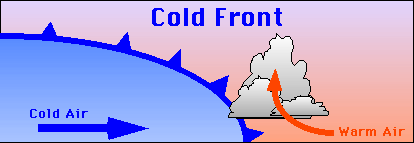|
|
Cold Fronts
A cold front is the transition zone where a colder, drier air mass is replacing a warm, moist air mass. Across the frontal zone, there is a sharp temperature decrease, a sharp humidity decrease, and a shift in wind direction. Often, there are clouds and precipitation. Cold fronts often bring very severe weather. This is due to the fact that warm, moist air is less dense than cold, dry air. The warm, moist air is forced upward as the cold front moves in, causing thunderstorms to form. Notice that the leading edge of the cold front has a high angle, which can rapidly force warm, moist air aloft.  There are specific weather conditions associated with all fronts, and cold fronts are no exception. The table below (from Ahrens' "Meteorology Today", a superb meteorology textbook), shows the "typical" conditions associated with cold fronts:
Confused? Have a question? If so, check out the Frequently Asked Questions (FAQ) page or send mail to the OS411 tutor (os411tutor@shodor.org) with your question! Report technical/content problems here |
|
|